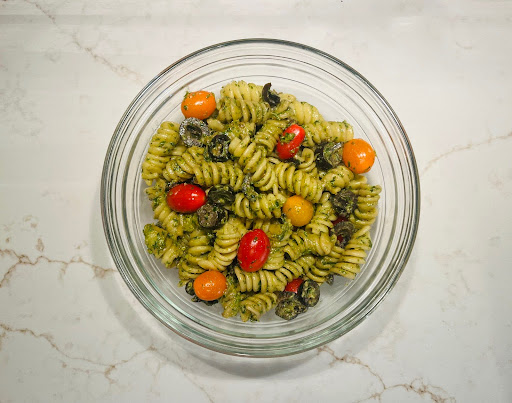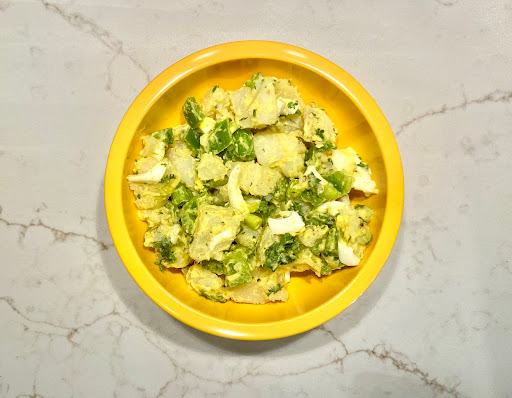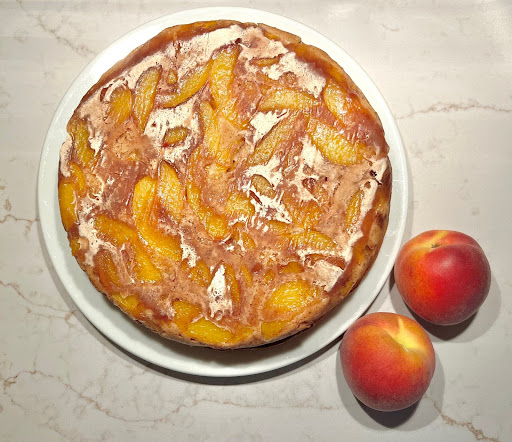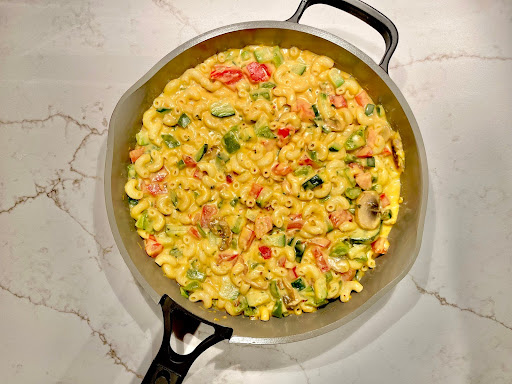Ever had mandarins that were not as sweet as you wanted? Don’t toss them-instead, enjoy this fruity, spring-flavored Blueberry Mandarin Orange Cake!

THE INGREDIENTS:
THE CAKE
Freshly Juiced Mandarin Orange: This mandarin orange juice adds a bit of acid to our cake, helping both with the rise AND getting that tangy orange flavor across. If you don’t have mandarins on hand, however, don’t let it deter you! Squeeze some oranges instead, or even lemons for a slightly different flavor: lemon blueberry cake! We recommend freshly squeezed fruit juice as opposed to store-bought juice. Think of fruit like black pepper. When you grind it yourself, the flavor is so much stronger. When it is ground in advance, its flavor fades away on the shelf before you even buy it. The same goes for fruit juice! However, using what you have on hand is a great idea and this cake will still be delicious.
Although we’re satisfied with the orange flavor in this cake, you can increase the flavor by concentrating your orange juice. This involves putting 1 cup of orange juice or more on the stove and cooking it down until only ½ a cup, which is the amount needed in the recipe, is left. Make sure to not add it when it is piping hot! You could risk cooking the egg in this recipe and getting an egg-flavored cake. Yuck.
How many mandarins is a ½ cup? Roughly 2-3. How many lemons? Roughly 2-3. How many oranges? Roughly 1-2.
Milk: Now, why add milk to a cake instead of water? It involves thinking of what milk has that water doesn’t. Namely, some protein and some fat! Just like hot cocoa tastes more creamy and delicious with milk instead of water, the same goes for cake. This cake is soft, delicate, and moist. You don’t taste milk in this cake, but it is like an egg. With it, the dessert has a better texture, even if you can’t put your finger on exactly why.
Although we use 2% milk, we recommend using what you have on hand. We try to steer away from skim milk, however, as it is missing the fat. If skim milk is all you have on hand, melt around ½ a tablespoon of butter and stir it into your milk before proceeding with this recipe. Either that, or you could even replace 1-2 tablespoons of your ½ cup of skim milk with heavy cream!
Vegetable Oil: We said milk adds moisture to cake, but the moisture actually comes from both the milk and the oil! If you were to replace this vegetable oil with butter, you would get a drier and dense cake. Oil is pure fat, whereas butter has a little bit of extra things (proteins because it’s dairy, and so on..) that make it act differently during baking. Oil is also a liquid at room temperature, whereas butter is more of a soft solid. These different states with temperature also affect the cake’s temperature after it is baked and cools back down to room temperature (or even goes in the fridge!). You can replace this vegetable oil with any neutral oil, but oil is the key towards the soft texture of our cake!
Egg: Eggs are our binder-bringing both our wet and dry ingredients together and holding them in place. Without eggs, a cake is at risk of being an overly crumbly mess. However, be careful to adjust the amount of egg in this recipe! Adding more may seem like the best way to get a solid, no crumbs at all cake. On one hand, that may work, but your cake could be heavy and dense! Although it hasn’t happened to us with this Blueberry Mandarin Orange Cake recipe, we have even found adding too many eggs turns whatever flavor you are making into an “egg cake”-yuck. Making this an eggless cake, though, will change the texture to one that is less tender.
Flour: This is an ingredient you wouldn’t want to forget in this cake! Flour adds thickness to our cake, as well as texture. We don’t recommend changing the amount of flour in this recipe. When too much flour is added to a cake, it becomes dense and dry. Not only that, but the more flour there is, the more spread out your flavor is! Less flavor per bite isn’t the goal of most bakers, we believe. If you go too skimpy on the flour, though, then your cake will be all gummy, not fluffy and moist. If you don’t have all purpose flour on hand, all we can recommend at the moment is cake flour as a substitute.
White Sugar: In this Blueberry Mandarin Orange Cake, we wanted the fruit to shine! That’s part of the reason why we used white sugar to sweeten this cake. White sugar’s pal, brown sugar, often incorporates a more caramel-like flavor due to the presence of molasses. White sugar, on the other hand, adds sweetness with no fuss-perfect when we’re trying to let the orange zest shine through. In addition to that, this cake is already at its maximum moisture capacity, in our opinion, and using it brown sugar would have made it over the top, too wet!
Salt: Don’t worry, this cake isn’t savory! Salt, instead, helps to balance all the flavors going on in this cake and leads us to appreciate the sweetness even more.
Baking Powder: You’ll see we use both baking powder and baking soda in this recipe, and you are right to wonder why! Baking powder, unlike baking soda, does not rely on an acid to react. Instead, think of baking powder as everything needed, all-in-one! However, this comes with a drawback. Baking powder does not give as strong of a rise as baking soda. We use it to supplement the baking soda, as too much a strong thing can be quite bad! In addition to that, since it is not dependent on acid, it does not mingle with and neutralize our orange juice-more orange flavor and zing, please!
Baking Soda: Here’s our strong component! Baking soda provides an aggressive rise, which is mellowed out by baking powder. It reacts with our acid (orange juice), in order to get the tall, fluffy cake we love. We like to supplement it with baking powder because too much baking soda has quite a potent, chemical flavor. In addition to that, we don’t want it to take over our orange juice flavor and too much baking soda can lead to a cake-maker’s enemy…sinking!
Blueberries: You can probably guess why these are here! These blueberries are juicy, fruity bursts throughout the cake. Although they aren’t needed in this recipe, blueberries pair incredibly well with citrus and are a great way to use up fruit you have on hand. Don’t have blueberries? Reach for cranberries or strawberries!
Mandarin Orange Zest: Although we add orange juice to this Blueberry Mandarin Orange Cake, that alone is not enough for the flavor we want. Orange juice brings the tart flavor, but zest is what packs most of our flavor punch. Depending on your preference, you can increase or decrease the zest amount! Although decreasing will lead to a milder flavor, it may be what you enjoy. If you increase the zest amount, know that overdoing it can make the cake hard to eat! We recommend slowly changing the amount of zest until you get to your personal preference. Again, if you do not have mandarins on hand, we recommend using lemons or oranges for both your juice and your zest.
THE GLAZE
Powdered Sugar: It wouldn’t be a glaze without powdered sugar! If you were to use white or brown sugar, you would get a grainy mess. Powdered sugar, which has much smaller particles, mixes perfectly into our cream, getting that sweet and smooth texture we love. If you increase the amount of powdered sugar in this glaze, it will be sweeter and thicker. If you reduce it, it will be thinner and less sweet.
Cream: Cream may not sound much more different than milk, but it makes a world of difference when it comes to glazes! Cream’s thickness and fat content is what brings the glaze together. If you were to use milk, even whole milk, you instead get a watery mess that would require throwing out the whole thing and starting over…you can guess how we figured that one out!
Mandarin Orange Zest: To have orange flavor in a glaze, it is best to use zest over juice. Not only is juice’s flavor a little weaker, but it would risk turning the glaze into a watery mess. By adding zest, you get a very adjustable, bright mandarin or orange flavor. We recommend starting with the amount stated in our recipe, doing a taste test, and adding a bit more if desired! If you are looking for a glaze with a light orange flavor, start with half our amount stated and go from there.
KEY INFORMATION:
Why Do Blueberries Sink in Muffins and Cakes? Imagine you have dumped shampoo into a bowl. Then, you added small rocks on top. You’d expect the pebbles to sink, even though the shampoo has some thickness to it, right? Now, realize that the “shampoo” represents our cake batter and the “pebbles” are our blueberries! Blueberries are more dense than our cake batter, so they will move through it, aiming for the bottom of your pan.
How Can I Make Blueberries Not Sink in Muffins and Cakes? Now, you probably want blueberries evenly distributed throughout instead of all at the bottom. As a quick rebuttal, however, let me tell you: this Blueberry Mandarin Orange Cake tastes the same regardless, and the cake can still look delicious anyway. You can guess we’ve let the blueberries sink plenty of times, with no complaints here! What’s at fault for our blueberries sinking is our thin cake batter, since it is much less dense than a blueberry itself. With that being said, thickening the batter is not an option, as that would completely change the entire cake. Coating the blueberries in flour is also a useless trick, as well.
Now, if you really want the blueberries to not sink in, we recommend the “layering and placing” method. Pour ⅓ of your cake batter, then lightly place ½ cup of blueberries on top of that layer. Pour another ⅓, lightly place the remaining ½ cup of blueberries, and top with the remaining batter. Make sure to work delicately. We recommend placing the blueberries instead of mixing them into part of the batter and dumping because that extra force applied while putting them on top of the blueberry-less layer can just make them sink anyway, since our cake batter is quite thin! However, if you are ever making a cake with a slightly thicker batter, that may work just fine.
Can I Use Oranges Instead of Mandarins in Baking Recipes? Yes, mandarin oranges and oranges have a similar enough flavor that they are interchangeable. Keep in mind that you’ll need roughly 2 mandarins per orange, even up to 3.
What Goes with Blueberry Mandarin Orange Cake? Going for a dessert spread or just trying to decide what to serve for lunch or dinner before bringing out the cake? We’ve got this handled for you! For a pre-cake meal, we recommend something with a light, fresh flavor. Nothing too dense! Try out our Pasta Primavera, or a meatloaf with mashed potatoes and brown butter brussels sprouts or glazed carrots. Going for a dessert spread fit for a large family gathering? We recommend keeping up on the fruit theme! Try out cinnamon apple cake, topped baked peaches, any muffin with fruit mixed in, and oatmeal raisin cookies as good companions. Chocolate or another overly-strong dessert risks taking over your guests’ palettes!
What’s The Difference Between Fruit Zest and Fruit Juice? Think of juice as the tartness/acid, and zest as the flavor! When you want that classic citrusy tang, you better make sure some juice ends up in your dessert. When you want to make sure “orange” comes to mind as you take a bite, you must include some zest. As the best of both worlds, we recommend including both the juice and zest in any dessert you’re making, unless it is a glaze (juice makes it too watery, in our opinion, before the tanginess starts having an impact).
Why Bake Cakes At Lower Temperatures? We have found that when we bake our cakes at lower temperatures, of course while also increasing the baking time, we don’t run into the dreaded cake-sinking! In fact, our cake has a flat top-perfect for having a pretty presentation. In addition to that, our cake stays wonderfully moist since it is not exposed to as hot an environment.
Why Mix All of the Dry Ingredients, and then Add Wet Ingredients? To be even! If you were to dump everything in and then mix, you risk some areas being more concentrated in your leaveners, leading to a…wacky…rise. You also will need to mix your batter for less time if you have properly mixed the dry ingredients first. This is great to avoid overmixing, a downfall for too many cakes out there (it takes away the lightness).

Ingredients
Method
- Preheat the oven to 300 F / 150 C.
- In a large bowl, combine all of the dry ingredients. Mix.
- Next, add all of the wet ingredients (no blueberries yet!). Mix until combined.
- Method 1: Add in the blueberries and pour the cake batter in a greased 8×8 or 9×9 baking dish.
- Method 2: Add 1/3 of the cake batter to a greased 8×8 or 9×9 baking dish, then place 1/2 cup blueberries. Repeat. Finally, top with the remaining 1/3 cake batter. This reduces how much the blueberries sink!
- Bake the cake at 300 F / 150 C for 45 minutes.
- Once the cake has baked and cooled, make the glaze by combining the powdered sugar, cream, and mandarin orange zest.
- Pour the glaze over the top of the cake or spoon some onto each pre-cut piece.
- Enjoy!




Leave a Reply